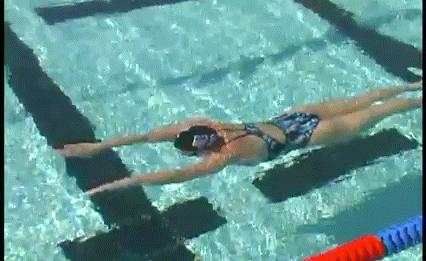Before the message area a friend wanted me to talk about the difference between "high-altitude wave frog" and "small wave frog", although I was not a breaststroke main athlete, the answer may not be comprehensive, but I decided to use my only knowledge to talk to you as much as possible about the difference between the two, hoping to bring out some views from it to help everyone.
High-altitude wave frog
First of all, the high-altitude wave frog (high-pull forward-punch breaststroke), the name is very graphic: pull the body high, and then rush forward.

It needs to be used to a strong core: the paddling and the core are up, and even a little backward, this action is very similar to pulling a bow; then use the core and arm to rush forward and shoot the arrow out.
The forward thrust is basically done on the water surface to reduce drag.
Pull up - forward charge, pull bow - archery in each action cycle, let us move the arm forward charge stage to reduce resistance and increase push.
Gaohang-style breaststroke was the mainstream competitive breaststroke technique around 2000, and the mainland's technical representative was Luo Xuejuan, the female frog king.
However, the high-altitude breaststroke also has shortcomings: although it can make the forward thrust more powerful, the amplitude of the action is large, the frequency is limited, and the high pull has a dead point, that is, a pause point, which will lead to inconsistencies between the cycle and the cycle action.
In competition, we not only have to ensure effectiveness, but also the faster the frequency can bring us faster speed.
However, effectiveness and frequency are mutually selective at some level, and today's mainstream wavelet frog technology makes a new trade-off between effectiveness and frequency.
Small wave frogs
The small wavelet frog is closer to the butterfly technique, although the butterfly itself originates from breaststroke, but with the development, it is a benign trend to turn around and learn from it.
With the stroker body is lifted instead of the core active pull up and backward, the undulation is lower, and then the arm is moved into the water, and the front reaches out to move the arm on the surface of the water, and the body is closer to the wave undulation, rather than the obvious pull up and forward.
In fact, this is a mathematical problem, with smaller body ups and downs in exchange for faster frequencies, although sacrificing some of the power of the forward moving arm, but the two are still worth it.
The small wave frog gradually became the mainstream technology of the modern competitive wave frog, and the British swimmer Adam. Pitti is a representative of this technology.
High-altitude vs small wave frog
At the level of physical fitness: the high-altitude breaststroke needs a stronger core to do support, without the core to do the foundation, it is difficult to pull up and pounce; the small wave frog needs to pay more physical energy because of the faster action frequency, once the physical fitness is missing, the rhythm of the action will begin to be chaotic, the legs cannot keep up with the hands or the hands cannot cooperate with the legs.
At the same time, both need very reasonable hand and leg movements and rhythm, or that sentence: the wave frog is the most technical swimming style.
epilogue
The above is today's content, the analysis may not be comprehensive and accurate, for reference only, the last nonsense: swimming enthusiasts always feel that being able to swim butterfly is the big god, and in the eyes of professional athletes can swim well is the big god, the technical difficulty is really not a level.